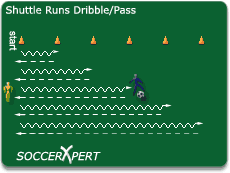Shuttle Runs Fitness Exercise– Dribble Pass
Shuttle runs are a fundamental fitness training exercise to build soccer endurance.

soccer shuttle runs, soccer fitness exercises, doggies, yo-yo, fitness training, soccer endurance, exercise, drills
Shuttle runs are a fundamental fitness training exercise to build soccer endurance.
In soccer the shuttle run, often called doggies or yo-yo’s, is a fundamental fitness training exercise to build soccer endurance. The shuttle run is a great fitness exercise to include in your soccer training since soccer is a constant stop-and-go sport. This movement represents an important soccer specific movement and is a great exercise to not only build speed, stamina, acceleration, and endurance, but by adding a ball it can also work on controlling the soccer ball at top speeds when your body’s become tired and fatigued.
You will need the following to perform this exercise: cones or markers, a soccer ball, and a wall or a person to return the ball to you.

To set up the Dribble/Pass Shuttle Runs exercise mark off 6-8 cones 5 yards apart in a single line. Make sure the player has gone through a proper warm-up and stretch prior to starting this fitness exercise. Each player should perform approximately 4-5 sets.
To begin the exercise, the working player will start with the soccer ball on the first cone and dribble full speed to the first cone, cut the ball quickly and pass to the return player or wall and sprint back to the starting marker without the ball. The return player should stop the ball near the starting line where the working player should quickly gain possession and dribble with speed to the 2nd marker. This pattern should be repeated for each of the cones.
To add a little variation to the shuttle runs exercise, have the return player toss a ball to the working player as they are approaching the starting cone and the working player should quickly control the ball, finish their run to the starting line, and dribble to the next marker as before. A specific body part can be isolated by having the return player throw to a certain body part such as: thigh traps, chest traps, or traps with the feet.




